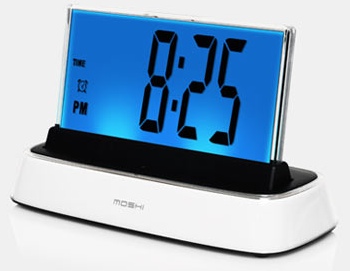 I’ve been wondering how long it’ll be before we start talking to all our appliances and gadgets, just like the gang on Star Trek talks to their computers. Typing, pressing buttons, waving wands around in the air: it’s all so inefficient! We should be able to simply speak to our gadgets to have them do our bidding. Today we’re one step closer to that golden Utopia, with Moshi, the voice controlled alarm clock.
I’ve been wondering how long it’ll be before we start talking to all our appliances and gadgets, just like the gang on Star Trek talks to their computers. Typing, pressing buttons, waving wands around in the air: it’s all so inefficient! We should be able to simply speak to our gadgets to have them do our bidding. Today we’re one step closer to that golden Utopia, with Moshi, the voice controlled alarm clock.
Moshi comes in three sizes: a full-size model, a diminutive “Mini” size, and a svelte little travel size. A clock radio is coming soon, as is the obligatory Moshi iPhone app. Construction of the model I tested was good, and the numbers are beautifully illuminated.
The Good
It’s great to be able to simply speak a time to your alarm clock, rather than press the “Hour” button a gazillion times as you cycle through the hours, inevitably going past your desired time at least twice. Moshi comes with three alarm sounds, and supports your standard nine minute snooze interval. It also has three different “sleep sounds”: white noise, a forest, and the ocean. Moshi will play a sleep sound for five minutes to help you drift off.
In addition to telling you the time, date, and alarm settings, Moshi has a thermometer which can be used to tell you the temperature in your room. This is actually an interesting feature, I think. There’s also a “night light” you can engage. By default Moshi will cycle through various colors on its face, but if this annoys you you can simply flip a switch on the back of the unit to force Moshi to use a single static color.
I really like the idea of being able to ask the time from my alarm clock. My vision is pretty bad, so when I’m lying in bed I am required to put on glasses to see the alarm clock. Being able to ask Moshi to tell me the time is actually a pretty big deal, in my mind.
The Bad
You cannot interrupt Moshi. Moshi does not listen to you when it’s speaking, or playing the alarm, or playing a sleep sound. The only way to interrupt Moshi is to press the display face, which is mounted atop a rocker switch. Pressing the face engages the snooze, or turns off the sleep sound, or cancels the current voice prompt.
If you don’t manually engage the snooze, Moshi will helpfully do this for you after one minute of alarm. During that minute, the alarm sound will slightly increase in volume each time it plays, to helpfully get your lazy ass out of bed. Whether you manually engage the snooze or not, you need to say “Hello, Moshi. Turn off the alarm” to actually get it to turn off.
You can program the date into Moshi, so that it can recite it back to you when asked; but this is strictly a manual operation using old fashioned buttons. There’s no way to simply speak the date to Moshi, which I find somewhat perplexing. Oh well.
The biggest problem I found with Moshi, though, was accuracy. Although my little video doesn’t show it, I really only had about a 75% success rate speaking to Moshi. When I would say “Set time” Moshi would prompt me to set the alarm time. Setting the correct time or alarm time was sometimes frustrating, as Moshi would hear something very different from what I said. “Nine” was often misinterpreted as “five”, and “ten” would result in a “seven” about half the time. If you speak slowly, and loudly, Moshi will usually get things right; but be prepared for a little frustration.
My second biggest gripe is with Moshi’s constant “Welcome, command please” response to every input. I can understand that happening the first couple of times, to ensure that you know that Moshi is listening to you. But if I wake up in the middle of the night and want to check the time, I think a simple chime, ding, or change of light would be more appropriate.
The Bottom Line
If you like to talk to things, or you hate pushing buttons, then Moshi is a good choice for you. Me? I still want a Wake Up Light.